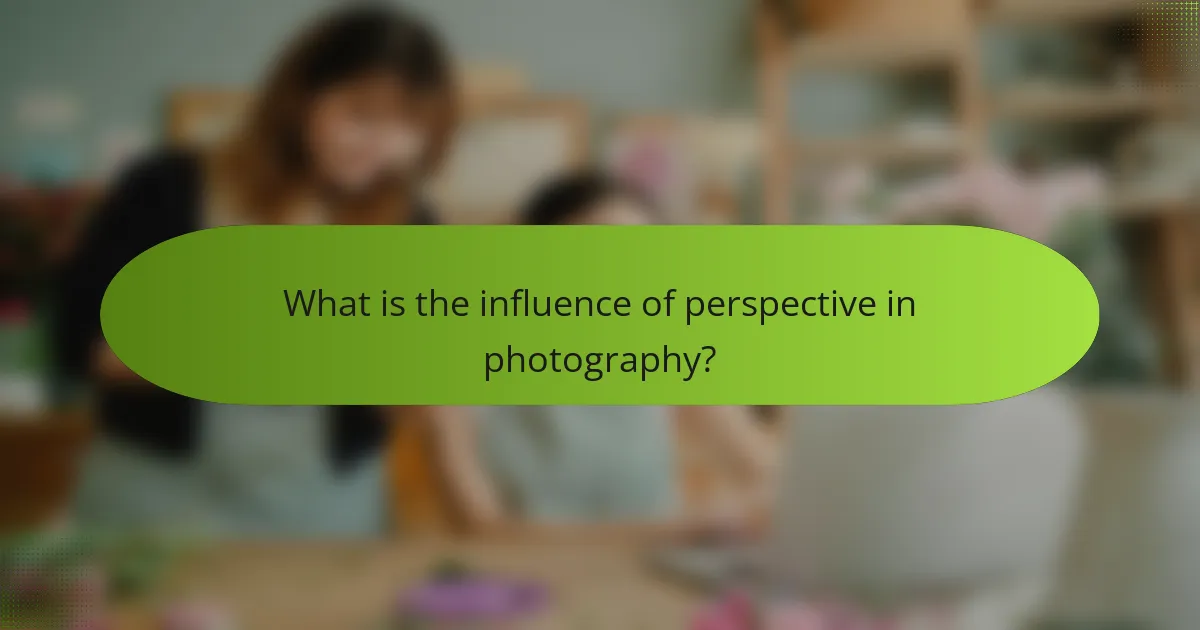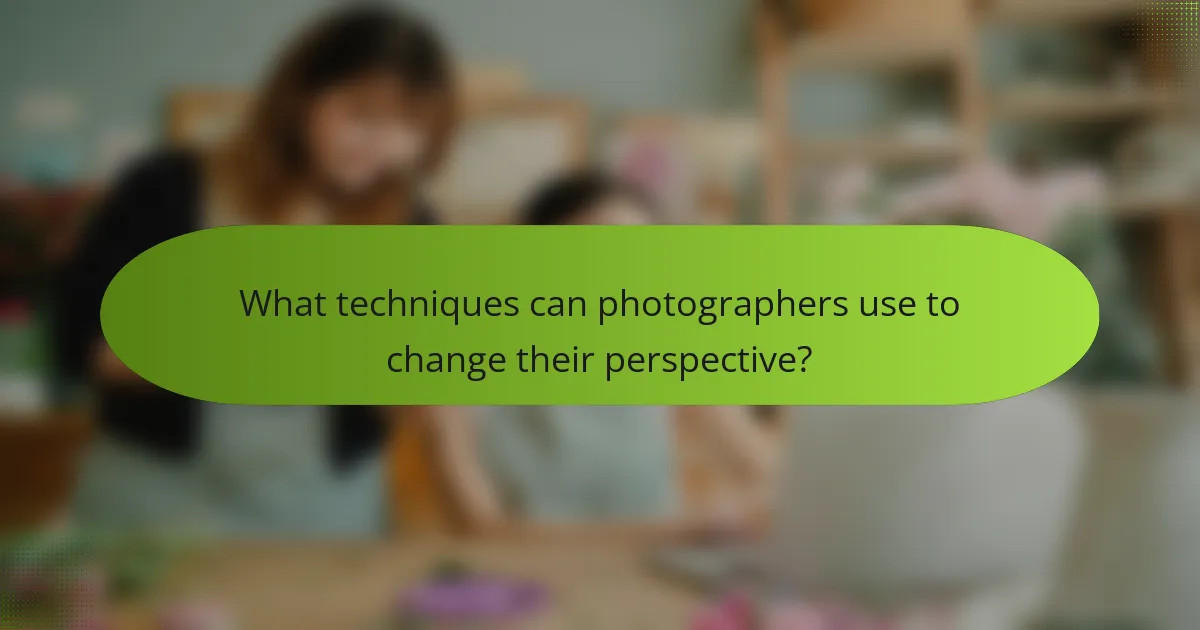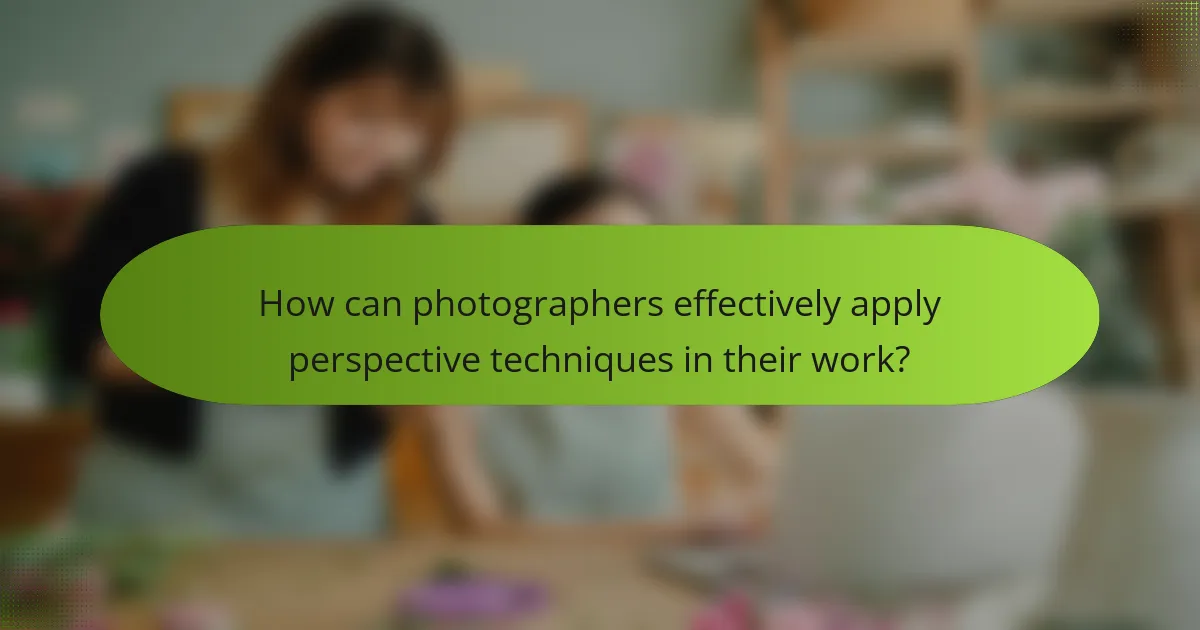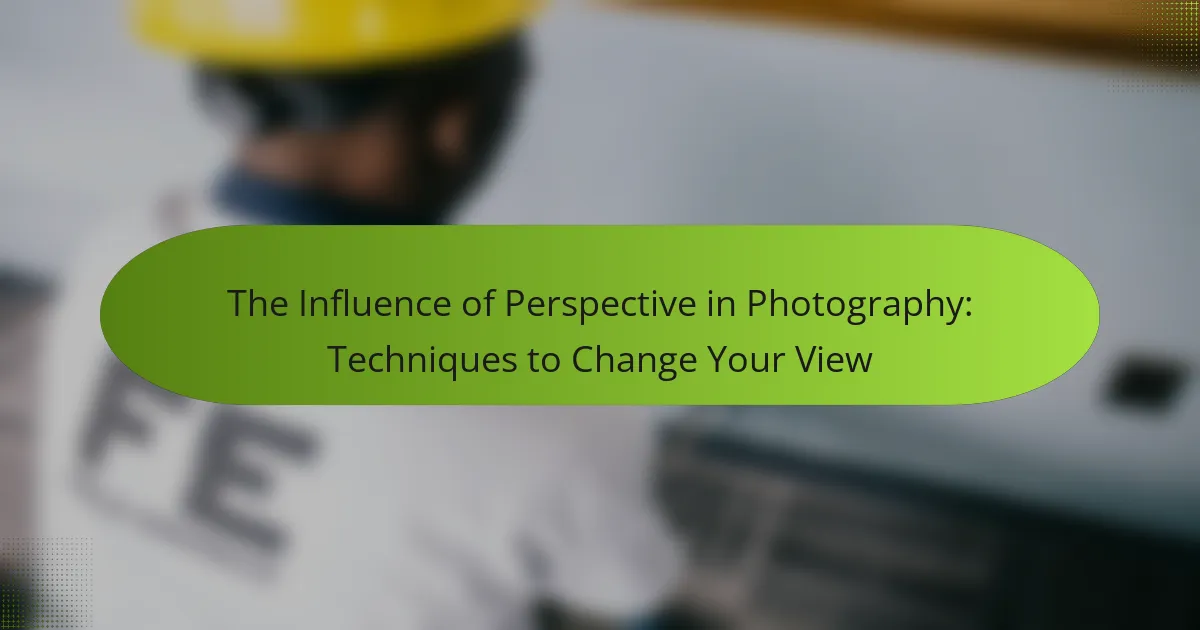
What is the influence of perspective in photography?
Perspective in photography significantly affects how an image is perceived. It determines the viewer’s emotional response and interpretation. Various angles can create depth or flatness in a photograph. A low angle can make a subject appear powerful, while a high angle can suggest vulnerability. The choice of perspective can highlight or obscure details. For instance, shooting from a distance can capture context, while close-ups emphasize texture. According to a study by the University of California, Berkeley, perspective shapes the narrative conveyed in visual storytelling. This demonstrates that perspective is essential for effective communication in photography.
How does perspective affect the viewer’s perception of a photograph?
Perspective significantly influences how a viewer perceives a photograph. It determines the angle and distance from which the subject is captured. Different perspectives can evoke various emotions and interpretations. For example, a low-angle shot may make a subject appear powerful. Conversely, a high-angle shot can render the subject vulnerable.
Research indicates that perspective alters spatial relationships within the image. A closer perspective can create intimacy, while a distant perspective may suggest isolation. Additionally, the choice of perspective can highlight specific attributes of the subject. This manipulation affects the viewer’s emotional response and understanding of the photograph.
In summary, perspective shapes the viewer’s perception by influencing emotional tone, spatial relationships, and the overall impact of the image.
What are the different types of perspective in photography?
The different types of perspective in photography include linear perspective, atmospheric perspective, and bird’s-eye view. Linear perspective creates depth by converging parallel lines towards a vanishing point. It is commonly used in architectural photography. Atmospheric perspective uses color and clarity to depict distance. Distant objects appear lighter and less detailed. Bird’s-eye view captures scenes from above, providing a unique angle and context. Each type of perspective alters the viewer’s perception of the subject. These techniques are essential for creating compelling compositions in photography.
How does perspective alter the emotional impact of an image?
Perspective significantly alters the emotional impact of an image by influencing how viewers interpret the scene. Different angles and viewpoints can evoke distinct feelings and narratives. For instance, a low-angle shot can create a sense of power and dominance, while a high-angle shot may convey vulnerability or insignificance. The choice of perspective affects composition, leading to varying emotional responses. Research in visual perception shows that perspective shapes viewer engagement and emotional resonance. A study by Palmer et al. (2011) in the Journal of Vision found that perspective manipulation directly affects emotional interpretation in visual stimuli. Thus, perspective is a crucial element in photography that shapes emotional experiences.
Why is perspective considered a vital element in photography?
Perspective is considered a vital element in photography because it influences the composition and visual storytelling of an image. It determines how objects relate to one another in space. A strong perspective can create depth and dimension, making a photo more engaging. For example, using leading lines can draw the viewer’s eye into the scene. Different angles can evoke various emotions and reactions from the audience. According to a study by the International Journal of Photography, perspective significantly affects viewer interpretation and emotional response. Thus, mastering perspective is essential for effective photographic expression.
How does perspective contribute to storytelling in visual art?
Perspective shapes the narrative in visual art by influencing how viewers interpret scenes. It establishes a sense of depth and spatial relationships. This can evoke emotions or highlight specific elements. For example, a low-angle perspective can make subjects appear powerful. Conversely, a high-angle view can create a sense of vulnerability. Artists use perspective to guide the viewer’s focus. This technique can also manipulate the perceived distance between objects. Historical examples include Renaissance artworks that utilized linear perspective for storytelling. Such techniques enhance the overall impact and meaning of the artwork.
What role does perspective play in composition and framing?
Perspective significantly influences composition and framing in photography. It determines how the viewer perceives depth, scale, and relationships within an image. By altering perspective, photographers can emphasize or diminish certain elements. For example, a low angle can make a subject appear more powerful. Conversely, a high angle can create a sense of vulnerability. Perspective also affects the overall mood and narrative of the photograph. A wide-angle lens can exaggerate foreground elements, enhancing spatial relationships. In contrast, a telephoto lens compresses space, bringing distant subjects closer. These techniques are essential for storytelling in visual art.

What techniques can photographers use to change their perspective?
Photographers can change their perspective using various techniques. One technique is altering the camera angle. By shooting from high or low angles, photographers can create different visual effects. Another technique involves changing the focal length. Using a wide-angle lens can exaggerate depth, while a telephoto lens compresses space. Additionally, photographers can experiment with framing. Including foreground elements can add depth and context to the image. Changing the distance from the subject also affects perspective. Moving closer or further away can dramatically alter the composition. Finally, utilizing reflections or mirrors can create unique perspectives. These techniques enable photographers to influence how viewers perceive the subject and scene.
How can altering camera angles enhance a photograph?
Altering camera angles can significantly enhance a photograph by changing the perspective and composition. Different angles can create a sense of depth and dimension. For example, shooting from a low angle can make subjects appear more powerful or imposing. Conversely, a high angle can provide a broader view of the scene.
Additionally, unique angles can highlight specific details that might be overlooked at eye level. This technique can also evoke different emotional responses from viewers. Studies show that varied perspectives can engage audiences more effectively. By exploring unconventional angles, photographers can create more dynamic and visually interesting images.
What are the effects of shooting from high versus low angles?
Shooting from high angles typically makes subjects appear smaller and less significant. This perspective can create a sense of vulnerability or powerlessness. In contrast, shooting from low angles often makes subjects look larger and more imposing. This viewpoint can convey strength or dominance. High angles can also provide a broader view of the environment. Low angles may emphasize foreground elements and create a feeling of depth. These effects are widely recognized in visual storytelling and cinematography. Studies in photography support these principles, demonstrating how angle influences perception and emotional response.
How does the choice of lens impact perspective?
The choice of lens significantly impacts perspective in photography. Different lenses alter the field of view and depth of field. A wide-angle lens captures more of a scene, creating a sense of depth and distance. This lens can exaggerate foreground objects, making them appear larger. Conversely, a telephoto lens compresses the scene, bringing distant subjects closer together. This lens creates a flatter perspective, reducing the sense of depth. The focal length of the lens directly influences how subjects relate to each other in the frame. Understanding these effects allows photographers to manipulate perspective intentionally.
What are some creative methods to experiment with perspective?
Use unusual angles to capture subjects from above or below. This alters the viewer’s perception significantly. Change your position to create a sense of depth. Moving closer or further away can enhance the composition. Experiment with foreground and background elements to create layers. This adds complexity to the image. Utilize reflections in water or glass to introduce a new perspective. This technique can create intriguing visual effects. Incorporate leading lines to draw the viewer’s eye through the frame. This guides attention and enhances perspective. Lastly, try panoramic shots to capture a wider view. This method can showcase landscapes or cityscapes effectively.
How can using foreground elements influence depth perception?
Using foreground elements enhances depth perception by creating visual layers in an image. Foreground elements provide context and scale, making distant objects appear further away. This technique utilizes relative size to emphasize the distance between the viewer and background elements. Studies show that images with clear foregrounds are perceived as more three-dimensional. For example, a photograph featuring a close-up object in the foreground can significantly increase the viewer’s sense of depth. This effect is rooted in human visual processing, where the brain interprets spatial relationships based on overlapping and size differences.
What role does lighting play in shaping perspective?
Lighting significantly influences perspective in photography. It affects how subjects are perceived and can alter the mood of an image. Different lighting conditions, such as natural light or artificial light, create distinct shadows and highlights. Shadows can add depth and dimension, while highlights can draw attention to specific areas. The angle of light also impacts the perception of texture and form. For instance, side lighting emphasizes contours, making subjects appear more three-dimensional. Conversely, flat lighting can diminish depth, resulting in a more two-dimensional look. Therefore, understanding lighting is crucial for photographers aiming to shape perspective effectively.

How can photographers effectively apply perspective techniques in their work?
Photographers can effectively apply perspective techniques by manipulating angles and distances. They should experiment with different viewpoints, such as shooting from high or low angles. This can dramatically alter the perception of depth and scale in an image. Using leading lines can guide the viewer’s eye and enhance the sense of perspective. Additionally, incorporating foreground elements can create a three-dimensional feel. Photographers can also play with focal lengths to compress or expand space. For instance, a wide-angle lens can exaggerate perspective, while a telephoto lens can flatten it. Understanding these techniques allows photographers to create more dynamic and engaging compositions.
What practical tips can help photographers master perspective?
Photographers can master perspective by using various practical tips. First, they should experiment with different angles. Changing the height or position of the camera can significantly alter the perspective. Second, utilizing leading lines helps guide the viewer’s eye. This technique creates depth and draws attention to the subject. Third, incorporating foreground elements adds layers to the composition. This can enhance the sense of depth in the image. Fourth, using a wide-angle lens can exaggerate perspective. This technique allows for more dramatic compositions. Fifth, practicing with depth of field can isolate subjects. A shallow depth of field blurs the background, emphasizing the main subject. Lastly, studying the work of other photographers can provide inspiration. Analyzing how they use perspective can inform personal practice. These tips can help photographers effectively manipulate perspective in their work.
How can photographers practice changing perspective in their daily shoots?
Photographers can practice changing perspective by experimenting with different angles and heights during their shoots. They should try shooting from low angles to emphasize subjects and create a dramatic effect. High angles can provide a broader view and context. Changing the distance from the subject can also alter the perspective, making it appear larger or smaller. Photographers can use wide-angle lenses for unique perspectives and to capture more of the scene. Incorporating foreground elements can create depth and interest. Regularly exploring new locations encourages fresh perspectives. Finally, reviewing and analyzing their images helps photographers understand the impact of perspective on their work.
What are common mistakes to avoid when working with perspective?
Common mistakes to avoid when working with perspective in photography include not considering the focal length. Using the wrong focal length can distort the subject’s appearance. Another mistake is neglecting the background. A cluttered background can distract from the main subject. Misplacing the horizon line can also lead to unbalanced compositions. Not experimenting with angles limits creative possibilities. Additionally, failing to maintain proper depth of field can result in a lack of focus on the subject. Lastly, overlooking the importance of leading lines can reduce visual interest in the photograph. These mistakes can hinder the effectiveness of perspective in photography.
How does understanding perspective lead to better photography outcomes?
Understanding perspective enhances photography outcomes by allowing photographers to manipulate depth and composition. A well-considered perspective can create a sense of scale and dimension in images. For instance, shooting from a lower angle can emphasize a subject’s height, while a higher angle can provide a broader view of the scene. This manipulation directly impacts viewer engagement and emotional response. According to a study published in the Journal of Visual Communication and Image Representation, images that effectively use perspective are perceived as more dynamic and interesting. This demonstrates that understanding perspective is crucial for capturing compelling photographs.
What are the long-term benefits of mastering perspective techniques?
Mastering perspective techniques in photography offers long-term benefits such as improved composition skills and enhanced visual storytelling. These techniques enable photographers to create depth and dimension in their images. As a result, images become more engaging and dynamic. Additionally, mastering perspective can lead to a unique style that sets a photographer apart in a competitive field. This distinctive style can attract a larger audience and more opportunities for collaboration. Studies show that photographers who utilize perspective techniques often receive higher praise and recognition for their work. Overall, the long-term benefits include artistic growth, professional opportunities, and a stronger connection with the audience.
How can photographers develop their unique style through perspective manipulation?
Photographers can develop their unique style through perspective manipulation by altering the angle and distance from which they capture images. This technique allows them to create distinctive compositions that reflect their personal vision. For example, shooting from a low angle can emphasize subjects and create a sense of grandeur. Conversely, a high angle can provide context and make subjects appear smaller or more vulnerable.
Experimenting with focal lengths can also enhance perspective manipulation. Wide-angle lenses can exaggerate depth and create dynamic scenes, while telephoto lenses compress space and isolate subjects. This variety in perspective can lead to unique storytelling in photography.
According to a study by the American Society of Media Photographers, photographers who consistently experiment with perspective report a stronger personal style. They find that changing viewpoint leads to fresh interpretations of familiar subjects. By embracing these techniques, photographers can distinguish their work in a crowded visual landscape.
The main entity of the article is ‘perspective in photography.’ This article examines how perspective influences viewer perception, emotional impact, and visual storytelling in photography. It discusses various types of perspective, such as linear and atmospheric, and techniques photographers can use to manipulate perspective, including altering camera angles and utilizing different lenses. Additionally, the article highlights the importance of perspective in composition, framing, and the overall effectiveness of photographic expression, providing practical tips for photographers to enhance their work through perspective manipulation.
